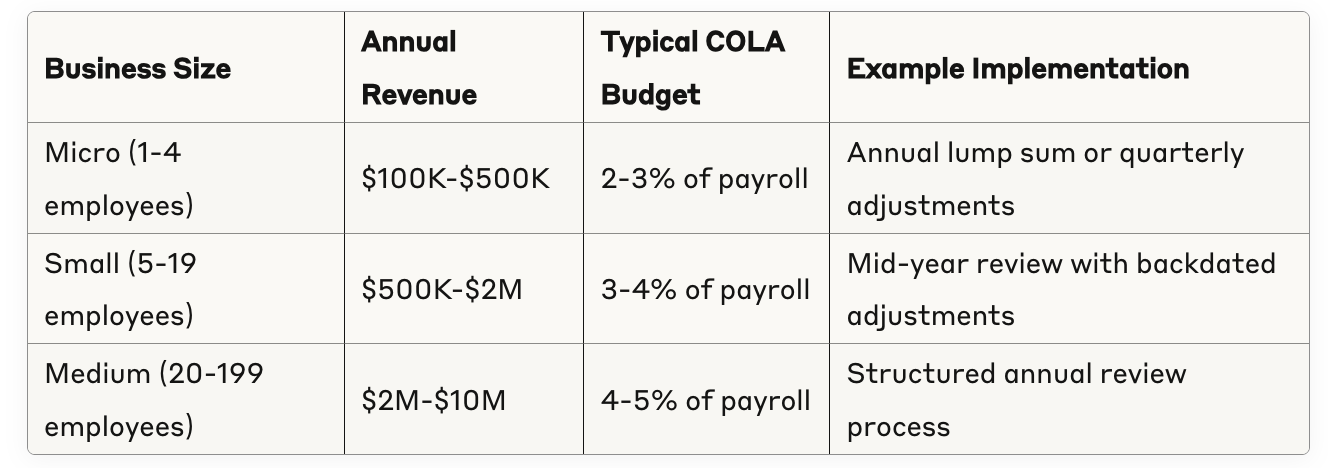
Published: July 2025
Updated: November 2025
The cost of living in Australia has increased significantly over the past few years, with inflation reaching levels not seen since the early 1990s. For small and medium business owners, understanding how to implement cost of living adjustments (COLAs) fairly and strategically is crucial for maintaining employee satisfaction whilst managing operational costs.
Cost of living adjustments are salary increases designed to help employees maintain their purchasing power as the cost of goods and services rises. Unlike merit-based pay increases that reward performance, COLAs are intended to offset inflation and rising living expenses.
According to the Australian Bureau of Statistics, the Consumer Price Index (CPI) increased by 4.1% in the year to December 2024, with housing costs, food, and transport being the primary drivers of inflation.
Unlike some countries, Australia doesn't mandate automatic cost of living adjustments for all employees. However, several legal frameworks influence how businesses approach salary adjustments:
Many employees covered by modern awards receive annual wage increases through the Fair Work Commission's Annual Wage Review. In 2024, the minimum wage increased by 3.75%, affecting approximately 2.7 million workers.
Whilst not requiring COLAs, the National Employment Standards ensure that any salary adjustments comply with minimum wage requirements and don't discriminate against protected classes.
The most straightforward approach uses the Consumer Price Index as published by the ABS.
Example Calculation:
Different Australian cities experience varying cost of living increases. Sydney and Melbourne typically see higher increases than regional areas.
Regional Adjustment Example:
Some industries experience higher cost pressures than others, particularly those affected by supply chain disruptions or labour shortages.

Financial Year Alignment: Many Australian businesses implement COLAs at the start of the financial year (July 1st) to align with budgeting cycles and tax planning.
Quarterly Reviews: Businesses in high-inflation periods may benefit from quarterly assessments rather than annual adjustments.
Transparent communication about COLA decisions helps maintain employee trust. Consider providing:
Maintain detailed records of:
Smart businesses establish a dedicated fund for cost of living adjustments:
Example Budget Allocation:
COLAs impact cash flow differently than performance bonuses:
These sectors face unique challenges with award wage increases and high turnover rates. COLAs may need to exceed award minimums to retain skilled staff.
Knowledge workers often expect COLAs that maintain their standard of living, particularly in expensive cities like Sydney and Melbourne.
Businesses in this sector may need to balance COLAs with investment in automation and efficiency improvements.
Instead of straight salary increases, consider:
Combine cost of living elements with performance metrics:
Share business success with employees through:
Track these metrics to assess your COLA strategy:
Establish a systematic approach:
Don't assume national CPI figures apply equally to all locations. Sydney office workers face different cost pressures than regional employees.
Ensure COLAs are applied fairly across all employee groups to avoid discrimination claims.
Failing to explain COLA decisions can lead to employee dissatisfaction, even when increases are generous.
Unexpected COLA expenses can strain cash flow, particularly for smaller businesses.
Stay informed about:
Develop policies that can adapt to changing conditions:
Cost of living adjustments are an essential tool for Australian small and medium businesses to maintain competitive advantage in the talent market. By understanding the legal framework, implementing fair calculation methods, and maintaining transparent communication, businesses can use COLAs to support employee retention whilst managing operational costs effectively.
The key to successful COLA implementation lies in balancing employee needs with business sustainability. Regular review and adjustment of your approach ensures that your COLA strategy remains effective as economic conditions change.
Remember that whilst COLAs are important, they're just one component of a comprehensive compensation strategy. Combined with performance management, professional development opportunities, and positive workplace culture, well-planned cost of living adjustments can significantly contribute to business success and employee satisfaction.
Q: What are cost of living adjustments (COLAs)?
Cost of living adjustments are salary increases designed to help employees maintain their purchasing power as the cost of goods and services rises, offsetting inflation and rising living expenses, unlike merit-based pay increases that reward performance.
Q: What is the current inflation rate in Australia?
According to the Australian Bureau of Statistics, the Consumer Price Index (CPI) increased by 4.1% in the year to December 2024, with housing costs, food, and transport as primary drivers.
Q: Are cost of living adjustments legally required in Australia?
Australia does not mandate automatic COLAs for all employees, but modern awards and enterprise bargaining agreements may include annual wage increases through the Fair Work Commission's Annual Wage Review, which increased the minimum wage by 3.75% in 2024, affecting 2.7 million workers. COLAs must comply with National Employment Standards and minimum wage requirements without discrimination.
Q: How do you calculate a CPI-based COLA?
Use the Consumer Price Index: for an employee's current salary of $65,000 with a 4.1% CPI increase, the COLA is $65,000 × 4.1% = $2,665, resulting in a new salary of $67,665.
Q: How do regional variations affect COLA calculations?
Different cities have varying increases; for a $60,000 base salary, Sydney's 4.5% CPI increase gives $2,700 adjustment, while regional Queensland's 3.2% gives $1,920.
Q: What are practical implementation strategies for COLAs?
Align adjustments with the financial year starting July 1st for budgeting, or use quarterly reviews in high-inflation periods. Communicate transparently with calculation methodology, industry benchmarks, timelines, and tax impacts. Maintain records of CPI data, rationale, communications, and implementation dates.
Q: How should businesses budget for COLAs?
Establish a reserve fund; for $500,000 total payroll and 4% estimated COLA, reserve $20,000 with monthly allocations of $1,667. Consider cash flow impacts like permanent expense increases, compounding superannuation (11.5%), and WorkCover premiums.
Q: What are industry-specific considerations for COLAs?
In retail and hospitality, COLAs may exceed award minimums to retain staff amid high turnover. Professional services expect COLAs to maintain living standards in expensive cities. Manufacturing balances COLAs with automation investments.
Q: What are the tax implications of COLAs?
For employers, COLAs are tax-deductible, increase superannuation contributions (11.5%), and may affect Fringe Benefits Tax. For employees, COLAs are taxable, may push into higher brackets, and affect superannuation and government benefits.
Q: What are alternative approaches to traditional COLAs?
Offer flexible benefits like additional leave, development allowances, flexible working, or health benefits. Use performance-linked adjustments with base COLAs plus increases for high performers. Implement profit-sharing through bonuses, equity, or gain-sharing programs.
Q: How do you measure COLA effectiveness?
Track KPIs like employee turnover, job satisfaction scores, recruitment costs, productivity, and industry benchmarking. Conduct quarterly CPI monitoring, annual surveys, and standards benchmarking, adjusting methodology as needed.
Q: What common mistakes should be avoided with COLAs?
Avoid ignoring regional variations, inconsistent application leading to discrimination claims, poor communication causing dissatisfaction, and inadequate budget planning straining cash flow.
Q: How can businesses future-proof their COLA strategy?
Monitor economic trends like Reserve Bank interest rates, government policies, industry pressures, and international conditions. Develop flexible policies with minimum/maximum ranges, trigger points for adjustments, and emergency provisions for shocks.
If you require assistance with cost of living adjustments for your Australian business, Scale Suite provides services including bookkeeping, tax compliance, and financial reporting. These can assist with tasks such as payroll calculations, COLA budgeting, superannuation management, and tax implications analysis. For more details, visit www.scalesuite.com.au/services/finance.
Scale Suite delivers embedded finance and human resource services for ambitious Australian businesses.Our Sydney-based team integrates with your daily operations through a shared platform, working like part of your internal staff but with senior-level expertise. From complete bookkeeping to strategic CFO insights, we deliver better outcomes than a single hire - without the recruitment risk, training time, or full-time salary commitment.
Considering hiring finance staff?
We’ll show you the full cost of an internal hire vs our embedded team – and exactly how much you’d save.
We’ll reply within 24 hours to book your free 30-minute call. No lock-in contracts and 30-day money-back guarantee



